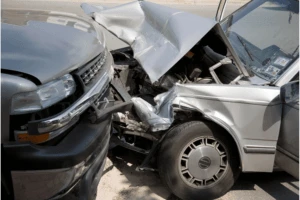
Head-on collision injuries are not only terrifying, but they can leave individuals with devastating harm, debilitating pain, and astronomical medical bills that will forever affect their whole family.
However, if you have been involved in a head-on car accident, you should not have to endure these horrific repercussions on your own. Instead, you deserve compensation and justice for the harm you sustained. That is why in this blog post, we will dive further into the topic of head-on collision accidents, describe the different types of injuries that can result, and the actions you need to take after the accident.
What are Head-On Collision Injuries?
A head-on collision also referred to as a frontal crash, is when cars are driving in opposite directions and end up crashing front to front. Although any motor vehicle accident can cause an injury, statistics show that head-on crashes are even more likely to result in a fatality or severe harm to the motorist or the passengers than other types of car crashes. In fact, the Insurance Institute for Highway Safety reported that head-on collisions tend to result in a 57% fatality rate.


Expect More, Receive More: Legal Support That Feels Like Family
Common Types of Head-On Collision Injuries
Even though a head-on collision can result in various injuries that can affect almost every part of the body, most of these injuries will lead to lifelong disabilities and significant trauma that will forever change your life. Yet, even though these injuries vary in scope and severity, the more common injuries that are frequently associated with head-on collisions include the following:
Whiplash Injuries
Whiplash is an injury to the neck which results from a rapid and forceful back and forth movement of the neck. It is typically seen in rear-end collisions but can also occur when motorists are involved in a frontal crash. Whiplash injuries can inhibit the range of motion in the neck and also lead to fatigue, dizziness, neck pain, and tingling or numbness in the arms.
Lower Extremity Harm
Another common injury following a head-on collision is harm to the lower extremities. This includes injuries to the toes, feet, knees, and upper and lower legs and often includes breaks, sprains, and soft tissue injuries. Although treatment may vary depending on the severity of the injury, lower extremity injuries often require surgery, physical therapy, and in more severe cases, amputation.
Traumatic Brain Injuries
Traumatic brain injuries (TBI) tend to result from a violent jolt or blow to the head or the body or when an object goes through the brain tissue. Generally, mild traumatic brain injuries tend to affect the brain cells temporarily, while more serious traumatic brain injuries often result in torn tissues, bruising, bleeding, and other physical damage to the brain. These injuries can also lead to long-term complications or death.
Spinal Cord Injuries
Spinal cord injuries result when any part of the spinal cord or nerves at the end of the spinal canal are damaged. However, these injuries frequently occur when there is a sudden blow or cut to the spine. Generally, symptoms of a spinal cord injury include a permanent loss of strength, sensation, and function below the injury site. Yet, even though treatments and rehabilitation devices can help stabilize the spine and allow people with this injury to lead productive, independent lives, there is no cure.
Crucial Steps to Take After a Head-On Collision
It is important to understand that following a head-on collision, there are steps you can take that will not only help keep you safe but strengthen your overall case. These steps often involve the following:
Contact 911
Usually, if you are involved in a head-on collision, the injuries are rather severe. That is why your priority needs to be getting emergency help by calling 911 and getting emergency responders to the scene as fast as possible. Once you receive the medical treatment you need, you can then deal with the insurance and legal matters that these cases typically involve.
Gather As Much Evidence As Possible
Once you are able, you should start collecting as much evidence from the accident as you can. This should include copies of the police report and all the medical records associated with the crash.
Contact an Experienced Car Accident Attorney
Car accident claims can get complicated, difficult, and tedious. Not only do they require you to have a thorough understanding of the state’s laws, but you also need to be able to provide detailed and relevant evidence and arguments to prove what happened and who was at fault. Fortunately, when you retain an experienced car accident lawyer, they can take care of this evidence-gathering process for you and prepare the strongest legal case on your behalf while you focus on what matters most — your healing and recovery.






